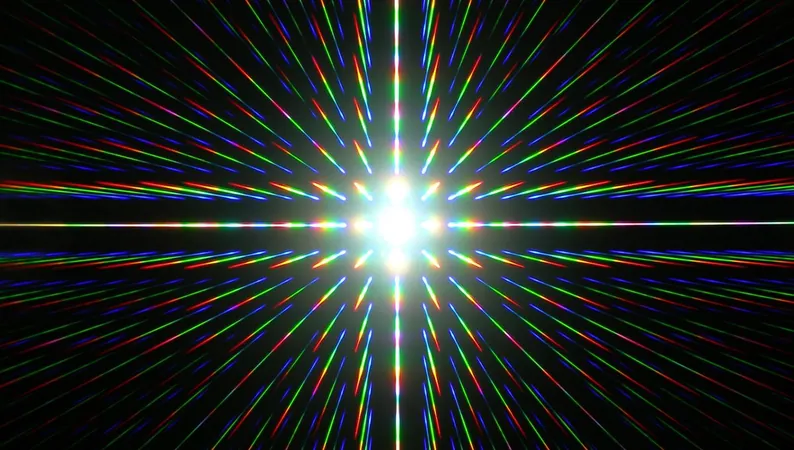
Breakthrough in Atomic Diffraction: Graphene Unlocks a Century-Old Puzzle
2025-01-03
Author: Li
Breakthrough in Atomic Diffraction: Graphene Unlocks a Century-Old Puzzle
In the ongoing pursuit to understand the dual nature of light and matter, researchers have finally cracked a longstanding challenge in the field of atomic diffraction, thanks to the remarkable properties of graphene. For millennia, philosophers and scientists debated whether light consists of particles or waves, converging in the early 20th century on the revelation that it embodies both. This concept was further extended by Louis de Broglie, who proposed that all matter exhibits wave-like characteristics.
Wave-Particle Duality and Historical Experiments
The paradigm of wave-particle duality was first illustrated through experiments with electrons, notably by George Paget Thomson and his colleague Alexander Reid, as well as in the famous Davisson-Germer experiment. By directing electrons through crystal lattices, they could be made to diffract in a manner akin to waves passing through narrow slits. This groundbreaking discovery not only reshaped fundamental physics but also paved the way for innovative technologies such as electron microscopy, transforming various scientific fields.
Challenges in Atomic Diffraction
However, demonstrating the same wave-particle duality with larger entities like atoms has proven to be far more challenging. Given that electrons are approximately 1,800 times lighter than hydrogen, they can more readily traverse and diffract through a crystal lattice. Historically, atomic diffraction was traditionally studied through reflections, where atoms were deflected off specially etched surfaces. Although it was established as a concept, researchers struggled to achieve diffraction of atoms as they passed through a crystal.
Groundbreaking Study with Graphene
A recent study by Carina Kanitz and her team from the Institute of Quantum Technologies and the University of Vienna has shifted this narrative. In a cutting-edge yet-to-be-peer-reviewed paper, they successfully demonstrated atomic diffraction through the use of a single layer of graphene. By bombarding hydrogen and helium atoms at high energy perpendicularly towards this atomically-thin sheet, the researchers observed a fascinating phenomenon: despite the considerable kinetic energy of the atoms—which would typically damage a crystal—the graphene remained intact.
Significance of the Findings
The team noted, "Despite the atoms' high kinetic energy and coupling to the electronic system of graphene, we observe diffraction patterns featuring coherent scattering of up to eight reciprocal lattice vectors." This indicates that the momentary interaction between the high-energy atoms and the graphene lattice is brief enough to prevent damage, enabling the atoms to diffract effectively.
Implications for Future Research
This breakthrough not only deepens our understanding of quantum mechanics but also opens the door to future innovations in various fields, including materials science, nanotechnology, and perhaps even quantum computing. The collaborative research is anticipated to spark new avenues for exploring atomic interactions and could lead to advanced applications in imaging technologies and beyond.
Conclusion and Future Prospects
For those keen on keeping up with the latest developments, a preprint detailing these findings is accessible via arXiv, awaiting peer review. This contemporary leap reestablishes the relevance of atomic diffraction studies and highlights the remarkable promise contained within two-dimensional materials like graphene. As we move forward, this research could redefine our understanding of matter at the atomic scale. Will this be the key to unlocking even greater secrets of the quantum realm? Stay tuned!

 Brasil (PT)
Brasil (PT)
 Canada (EN)
Canada (EN)
 Chile (ES)
Chile (ES)
 Česko (CS)
Česko (CS)
 대한민국 (KO)
대한민국 (KO)
 España (ES)
España (ES)
 France (FR)
France (FR)
 Hong Kong (EN)
Hong Kong (EN)
 Italia (IT)
Italia (IT)
 日本 (JA)
日本 (JA)
 Magyarország (HU)
Magyarország (HU)
 Norge (NO)
Norge (NO)
 Polska (PL)
Polska (PL)
 Schweiz (DE)
Schweiz (DE)
 Singapore (EN)
Singapore (EN)
 Sverige (SV)
Sverige (SV)
 Suomi (FI)
Suomi (FI)
 Türkiye (TR)
Türkiye (TR)
 الإمارات العربية المتحدة (AR)
الإمارات العربية المتحدة (AR)